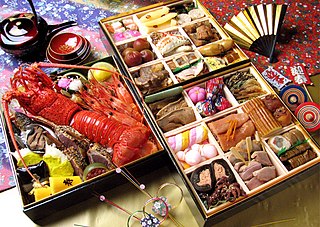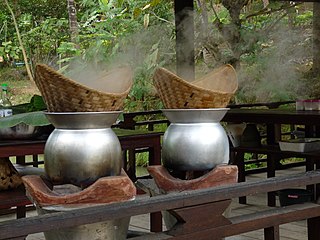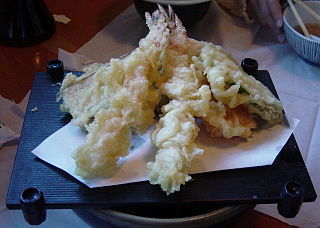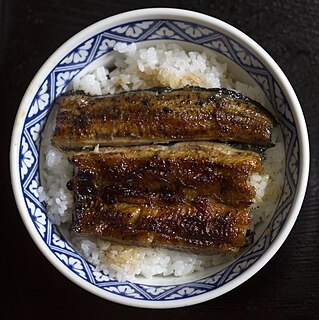
Cantonese cuisine or more accurately, Guangdong cuisine, also known as Yue cuisine (粵菜), refers to the cuisine of China's Guangdong Province, particularly the provincial capital, Guangzhou (Canton). "Cantonese" specifically refers to only Guangzhou or the language known as Cantonese associated with it, but people generally refer to "Cantonese cuisine" to all the cooking styles of the speakers of Yue Chinese languages from within Guangdong. The Teochew cuisine and Hakka cuisine of Guangdong are considered their own styles, as is neighboring Guangxi's cuisine despite also being considered culturally Cantonese. It is one of the Eight Culinary Traditions of Chinese cuisine. Its prominence outside China is due to the large number of Cantonese emigrants. Chefs trained in Cantonese cuisine are highly sought after throughout China. Until recently, most Chinese restaurants in the West served largely Cantonese dishes.

Buddhist cuisine is an East Asian cuisine that is followed by monks and many believers from areas historically influenced by Chinese Buddhism. It is vegetarian or vegan, and it is based on the Dharmic concept of ahimsa (non-violence). Vegetarianism is common in other Dharmic faiths such as Hinduism, Jainism and Sikhism, as well as East Asian religions like Taoism. While monks and a minority of believers are vegetarian year-round, many believers follow the Buddhist vegetarian diet for celebrations.

Japanese cuisine encompasses the regional and traditional foods of Japan, which have developed through centuries of political, economic, and social changes. The traditional cuisine of Japan, Washoku, is based on rice with miso soup and other dishes; there is an emphasis on seasonal ingredients. Side dishes often consist of fish, pickled vegetables, and vegetables cooked in broth. Seafood is common, often grilled, but also served raw as sashimi or in sushi. Seafood and vegetables are also deep-fried in a light batter, as tempura. Apart from rice, staples include noodles, such as soba and udon. Japan also has many simmered dishes such as fish products in broth called oden, or beef in sukiyaki and nikujaga.

Vietnamese cuisine encompasses the foods and beverages of Vietnam, and features a combination of five fundamental tastes in the overall meal. Each Vietnamese dish has a distinctive flavor which reflects one or more of these elements. Common ingredients include fish sauce, shrimp paste, soy sauce, bean sauce, rice, fresh herbs, fruit and vegetables. French Cuisine has also had a major influence due to the French Colonization of Vietnam. Vietnamese recipes use lemongrass, ginger, mint, Vietnamese mint, long coriander, Saigon cinnamon, bird's eye chili, lime, and Thai basil leaves. Traditional Vietnamese cooking is greatly admired for its fresh ingredients, minimal use of dairy and oil, complementary textures, and reliance on herbs and vegetables. With the balance between fresh herbs and meats and a selective use of spices to reach a fine taste, Vietnamese food is considered one of the healthiest cuisines worldwide. Due to the Chinese domination of Vietnam, Vietnamese cuisine is heavily influenced by traditional Chinese medicine.

Steaming is a method of cooking using steam. This is often done with a food steamer, a kitchen appliance made specifically to cook food with steam, but food can also be steamed in a wok. In the American southwest, steam pits used for cooking have been found dating back about 5,000 years. Steaming is considered a healthy cooking technique that can be used for many kinds of food.

Double steaming, sometimes called double boiling, is a Chinese cooking technique to prepare delicate food such as bird's nest soup and shark fin soup. The food is covered with water and put in a covered ceramic jar and the jar is then steamed for several hours. This technique ensures there is no loss of liquid or moisture from the food being cooked, hence it is often used with expensive ingredients like Chinese herbal medicines.

Misosoup is a traditional Japanese soup consisting of a stock called "dashi" into which softened miso paste is mixed. Many ingredients are added depending on regional and seasonal recipes, and personal preference.

Tempura is a Japanese dish usually consisting of seafood or vegetables that have been battered and deep fried. The dish was influenced by fritter-cooking techniques introduced by Portuguese residing in Nagasaki in the 16th century. The name "tempura" originates from the Latin phrase quatuor anni tempora, which refers to the Ember Days, during which no meat is consumed.

Donburi is a Japanese "rice bowl dish" consisting of fish, meat, vegetables or other ingredients simmered together and served over rice. Donburi meals are served in oversized rice bowls also called donburi. When need to distinguish, the bowl is called donburi-bachi (丼鉢) and the dish is called donburi-mono (丼物). Donburi are sometimes called "sweetened" or "savory stews on rice".

Wheat gluten is a food made from gluten, the main protein of wheat. It is made by washing wheat flour dough with water until all the starch granules have been removed, leaving the sticky insoluble gluten as an elastic mass which is then cooked before being eaten.

Cup Noodles is a brand of instant cup noodle ramen invented in 1971 and manufactured by Nissin, packaged in a foam food container, hard plastic or paper cup. Other brand names are used in specific countries, such as the singular Cup Noodle in Japan. The product has inspired numerous competing products, such as Maruchan's Instant Lunch.

Korean royal court cuisine was the style of cookery within Korean cuisine traditionally consumed at the court of the Joseon Dynasty, which ruled Korea from 1392 to 1910. There has been a revival of this cookery style in the 21st century. It is said that twelve dishes should be served along with rice and soup, with most dishes served in bangjja (bronzeware).

Nian gao, sometimes translated as year cake or Chinese New Year's cake, is a food prepared from glutinous rice flour and consumed in Chinese cuisine. While it can be eaten all year round, traditionally it is most popular during Chinese New Year. It is considered good luck to eat nian gao during this time, because nian gao is a homonym for "higher year." The Chinese word 粘 (nián), meaning "sticky", is identical in sound to 年, meaning "year", and the word 糕 (gāo), meaning "cake" is identical in sound to 高, meaning "high or tall". As such, eating nian gao has the symbolism of raising oneself taller in each coming year. It is also known as a rice cake. This sticky sweet snack was believed to be an offering to the Kitchen God, with the aim that his mouth will be stuck with the sticky cake, so that he can't badmouth the human family in front of the Jade Emperor. It is also traditionally eaten during the Duanwu Festival.
The tendons of certain animals are used as an ingredient in some Asian cuisines, including the Chinese, Japanese, Korean, Indonesian, Thai and Vietnamese traditions. Tendon is tough and fibrous, but becomes soft after a long period of cooking. In some cases it may be boiled for as long as eight hours, while in other dishes it is prepared by deep frying. It contains large amounts of collagen, and after boiling or stewing, it is sometimes described as mimicking the mouthfeel of high-fat cuts of beef despite its low fat content. One author described the taste of deep-fried tendon as being similar to chicharrón.

Shumai is a type of traditional Chinese dumpling, originating from Huhhot. In Cantonese cuisine, it is usually served as a dim sum snack. In addition to accompanying the Chinese diaspora, a variation of Shaomai also appears in Japan and various Southeast Asian countries.

Cooked rice refers to rice that has been cooked either by steaming or boiling. The terms steamed rice or boiled rice are also commonly used. Any variant of Asian rice, African rice or wild rice, glutinous or non-glutinous, long-, medium-, or short-grain, of any colour, can be used. Rice for cooking can be whole grain or milled.

Nasi tim is a Chinese-Indonesian steamed chicken rice. In Indonesian language nasi means (cooked) rice and tim means steam. The ingredients are chicken, mushroom and hard boiled egg. These are seasoned in soy sauce and garlic, and then placed at the bottom of a tin bowl. This tin bowl is then filled with rice and steamed until cooked. This dish is usually served with light chicken broth and chopped leeks.

Chinese regional cuisines are the different cuisines found in different provinces and prefectures of China as well as from larger Chinese communities overseas.

Kaiseki (懐石) or kaiseki-ryōri (懐石料理) is a traditional multi-course Japanese dinner. The term also refers to the collection of skills and techniques that allow the preparation of such meals and is analogous to Western haute cuisine.





















